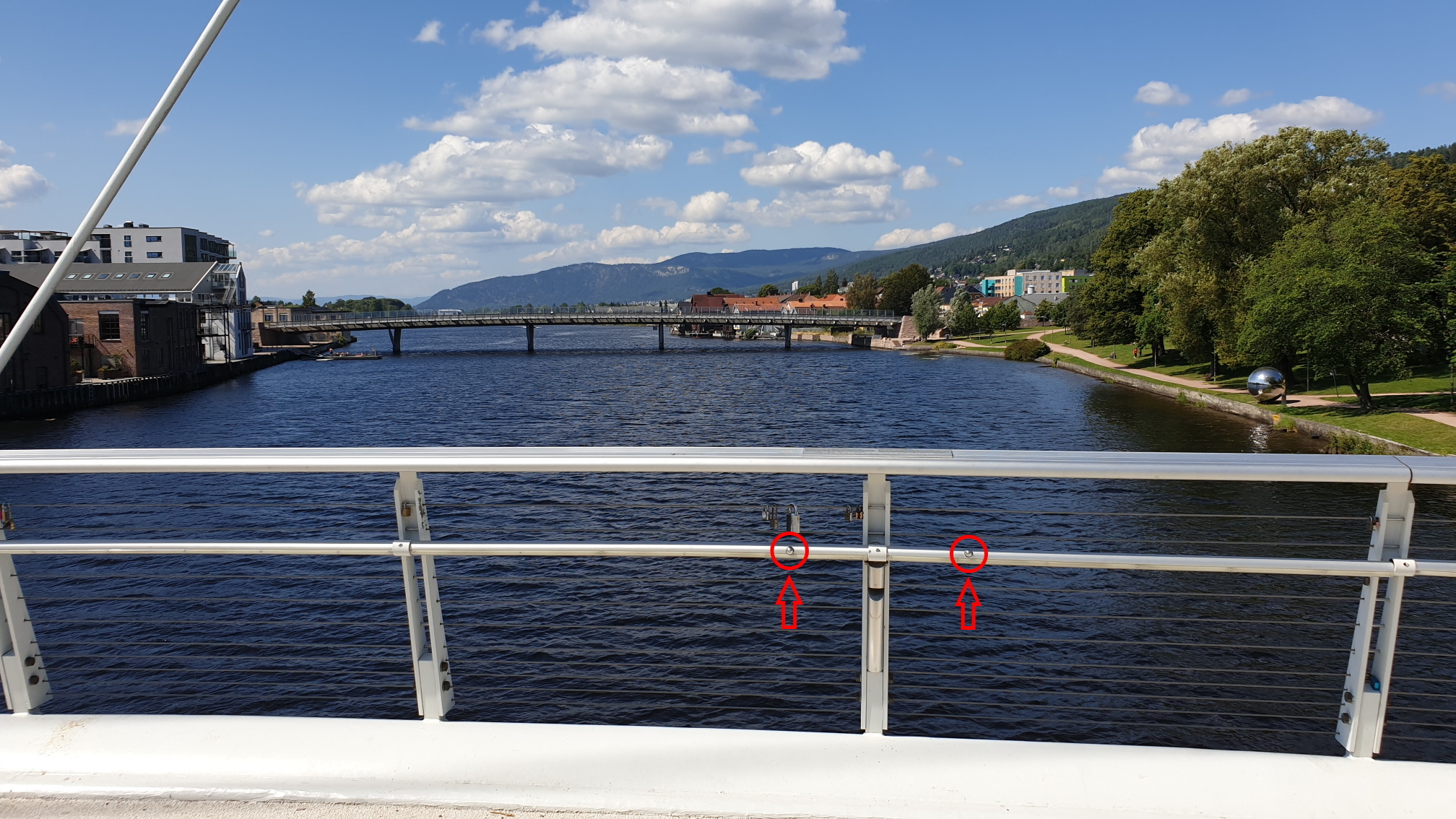

ELVEHARPEN
Elveharpen er en stålskulptur som består av to store kuler med innebygde høyttalere.
Bakgrunnen for kunstverket var en internasjonal konkurranse som ble arrangert i 2006. 38 kunstnere meldte sin interesse, fem av disse kom til finalen og vinneren ble Living Lenses, en kunstnerduo bestående av Po Shu Wang og Louise Bertelsen. Kunstverket ble montert sommeren 2008.
Elveharpen er finansiert som et spleiselag mellom Buskerud fylkeskommune, Drammen kommune, Entra Eiendom, Union Eiendomsutvikling, Sparebanken Øst og Aass Bryggerier.
Dette sttår skrevet ved skulpturen:
En sang til Nøkken
En gang var det vanlig for oss mennesker å synge til elver, vann, fossefall og de vetter som bodde der. Ypsilon-brua kan sammenlignes med en gigantisk harpe, og ved hjelp av den vil vi igjen kunne synge til Drammenselva og gjenskape harmoni med nøkken.
Alkymi av kunst og vitenskap
Vi har analysert bruas svingninger og funnet det klanglige midtpunkt på 1.253 Hz. Tonen er flyttet opp åtte oktaver til et lydbilde tilpasset det menneskelige øre. Dette gir oss en tone på 320.768 Hz som vi benytter som første tone i en musikalsk skala. Skalaen følger de klanglige trinn i gammel norsk folkemusikktradisjon.
Svingningene i brua blir registrert og overført trådløst til de to resonanskulene, en på hver elvebredd. I kulene er det lagret toner tatt opp fra syngende drammensere. Tonene er programmert til å tolke bruas svingninger. Når du krysser brua vil din vekt og gangrytme påvirke bølgebevegelsen og derved sangen. Resultatet er en elve-harpesang, som er unik for Drammen.
Elveharmoni
Diameteren på de to kulene er presist beregnet ved hjelp av Helmholtz resonansformel. Den største kulen er som et instrument ”stemt” etter egensvingingen i et vannmolekyl, og den minste ut fra egensvingingen i et is-molekyl. Sangen fra kulene gir derfor en gjenklang av vann- og ismolekylene i Drammenselva.
Vi inviterer deg til å synge en sang til Nøkken sammen med koret.
LIVING LENSES 2008
Louise Bertelsen, Po Shu Wang
|
Slik kan du lytte til Nøkkens bolig
Ved å gå til midten av Ypsilonbrua kan du lytte til Nøkkens Bolig.
Inspirert av Michael Faradays væskedynamoforsøk fra 1831 på Waterloo Bridge.

Drammenselvas mineralpartikler blir magnetiske av jordas magnetfelt og induserer en svak strøm i en lukket strømkrets. To kopperledninger er ført ned i vannet ved hver elvebredd og forbundet med de to knappene på rekkverket. Ved å berøre begge knappene slutter du strømkretsen med vannet og jorda, og du vil høre lyden av de molekylære sammenstøt i Nøkkens bolig.
Oppgaven
Ta et bilde av speilingen i en av kulene. Bildet legges ved i loggen din
Du kan velge selv om du vil være med på bildet eller ikke.

RIVER HARP
The River Harp is a steel sculpture consisting of two large balls with built-in speakers.
The background for the artwork was an international competition held in 2006. 38 artists announced their interest, five of which came to the final and the winner was Living Lenses, an artist duo consisting of Po Shu Wang and Louise Bertelsen. The artwork was mounted in the summer of 2008.
The River Harp is a financial cooperation between Buskerud fylkeskommune, Drammen kommune, Entra Eiendom, Union Eiendomsutvikling, Sparebanken Øst og Aass Bryggerier.
This is written by the sculpture:
A song for Nøkken
Once upon a time it was common for us humans to sing to the rivers, lakes and waterfalls. Those were the days when Nøkken was not the fearful character that lure folks to drowning with his beautiful music. Now with the Ypsilon Bridge built like a giant Harp it will help us to sing once more to Drammneselva and restore harmony with Nøkken.
The alchemy of art ans science
From dynamic analysis data of Ypsilon Bridge we identified its 1.253 Hz torsienal mode of oscillation to be the Tonal Center of the River Harp. We scaled the note eight octave to human hearing range. This gave us a 320.768 Hz pitch which we used as the Tonic (first note) to construct a musical scale that follows the harmonic progression of an Old Norwegian Singing tradition. Along the bridge deck three-axis accelerometers are installed to monitor its oscillations. The detected signals are wirelessly transmitted to these two spherical resonators on both banks of the river. Pre-recorded notes sung by local community members are programmed to interpret these oscillation modes.
Your crossing of the bridge will affect the modes therefore the chorus. The result is a River Harp chorus that is unique to Drammen, while evoking harmonic memories of the long lost tradition of singing to the rivers and lakes.
River Harmonics
The exact diameters ow the two resonators are determined by Helmholtz resonance formula calculation. The larger is tuned to the fundamental resonant period of the H2O water molecule and the smaller is tuned to that of the ice molecule. So when the chorus sings it resonates with the water- and ice-molecules in Drammenselva, securing our communication with Nøkken through his habitat in all seasons.
We invite you to join the chorus and sing into the resonators for Nøkken
LIVING LENSES 2008
Louise Bertelsen, Po Shu Wang
|
Eavesdropping on Nøkken
By walking to the middle of the Ypsilon Bridge you can eavesdropping on Nøkken
Inspired by Michael Faraday's 1831 liquid dynamo on the Waterloo Bridge.

Minerals carried by Drammenselva is a moving conductor running through Earth's magnetic field. The two knobs on the handrail are connected to two copper wires that run into the river. By touching them, your conductive self-connects with the river and the earth, completing the liquid dynamo circuit of nature. And that triggers the molecular jostling noise of Nøkkens habitat.
Logging task
Take a picture of the reflection in one of the resonators. Post the picture with your log
You can choose whether or not to join the picture
Virtual Rewards 2.0 - 2019/2020
This Virtual Cache is part of a limited release of Virtuals created between June 4, 2019 and June 4, 2020. Only 4,000 cache owners were given the opportunity to hide a Virtual Cache. Learn more about Virtual Rewards 2.0 on the Geocaching Blog.